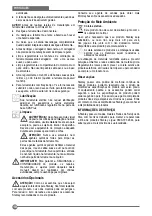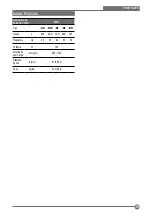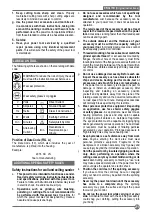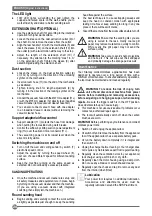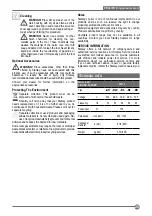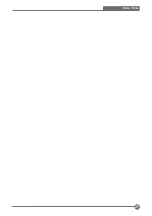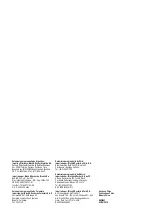
23
ENGLISH (
Original Instructions)
ELECTRICAL SAFETY
Your tool is double insulated; therefore no earth wire
is required. Always check that the main voltage
corresponds to the voltage on the rating plate.
Warning!
If the power cord is damaged, it must be
replaced by the manufacturer, authorized Stanley
Service Center or an equally qualified person in
order to avoid damage or injury. If the power cord is replaced
by an equally qualified person, but not authorized by
Stanley the warranty will not be valid.
USING AN EXTENSION CABLE
If it is necessary to use an extension cable, please used
an approved extension cable that fits the tool’s power input
specifications. The minimum cross-sectional area of the
conducting wire is 1.5 sq. mm. Cables should be untangled
before reeling up.
Cable cross-sectional
area (mm
2
)
Cable rated current
(Ampere)
0.75
6
1.00
10
1.50
15
2.50
20
4.00
25
Cable length (m)
7.5 15
25
30
45
60
Voltage
Amperes Cable rated current (Ampere)
115
0 - 2.0
6
6
6
6
6
10
2.1 - 3.4
6
6
6
6
15 15
3.5 - 5.0
6
6
10 15 20 20
5.1 - 7.0
10 10 15 20 20 25
7.1 - 12.0
15 15 20 25 25
-
12.1 - 20.0 20 20 25
-
-
-
230
0 - 2.0
6
6
6
6
6
6
2.1 - 3.4
6
6
6
6
6
6
3.5 - 5.0
6
6
6
6
10 15
5.1 - 7.0
10 10 10 10 15 15
7.1 - 12.0
15 15 15 15 20 20
12.1 - 20.0 20 20 20 20 25
-
BEFORE USE
♦ Before using the tool for the first time, it is recommended
to receive practical information.
♦ Always check that the supply voltage is the same as the
voltage indicated on the nameplate of the tool.
♦ Use suitable detectors to find hidden utility lines or
call the local utility company for assistance (contact
with electric lines can lead to fire or electrical shock;
damaging a gas line can result in an explosion;
penetrating a water pipe will cause property damage or
an electrical shock).
♦ Do not work materials containing asbestos (asbestos is
considered carcinogenic).
♦ Dust from material such as paint containing lead, some
wood species, minerals and metal may be harmful
(contact with or inhalation of the dust may cause allergic
reactions and/or respiratory diseases to the operator or
bystanders); wear a dust mask and work with a dust
extraction device when connectable.
♦ Certain kinds of dust are classified as carcinogenic
(such as oak and beech dust) especially in conjunction
with additives for wood conditioning; wear a dust
mask and work with a dust extraction device when
connectable.
♦ Follow the dust-related national requirements for the
materials you want to work with.
♦ Do not clamp the tool in a vice.
AFTER USE
♦ After switching off the tool, never stop the rotation of the
accessory by a lateral force applied against it.
ASSEMBLY AND ADJUSTMENT
WARNING: To reduce the risk of serious personal
injury turn tool off and disconnect tool from power
source before making any adjustments or
removing/installing attachments or accessorie.
Before reconnecting the tool, depress and release
the trigger switch to ensure that the tool is off. An accidental
start-up ca cause injury.
USE
Assemble foldable shaft
♦ Fully unfold the upper shaft and lower shaft(2a) (Fig.B).
♦ Push the folding lock 4 to the right position and keep
the tip adjacent to the handle (2b) (Fig.B).
♦ Press down the folding lock 4 to lock the shaft.
♦ Release the folding lock to fold the shaft.
Replace sanding pad
♦ Insert the hex wrench (13) (size 5) into the hexagonal
screw bolt on the sanding block.
♦ Hold the sanding pad firmly, and then turn the wrench
counter clockwise to dismount the pad.
♦ Install new sanding pad by tightening the bolt.
Attaching and changing sanding disc
♦ Place the sanding disc in the center of the sanding pad
and press on. The holes in the sanding disc must be in
alignment with the extraction holes in the sanding pad.
♦ For round sanding pad only: conduct a test run to
check that the sanding disc is clamped in the centre.










